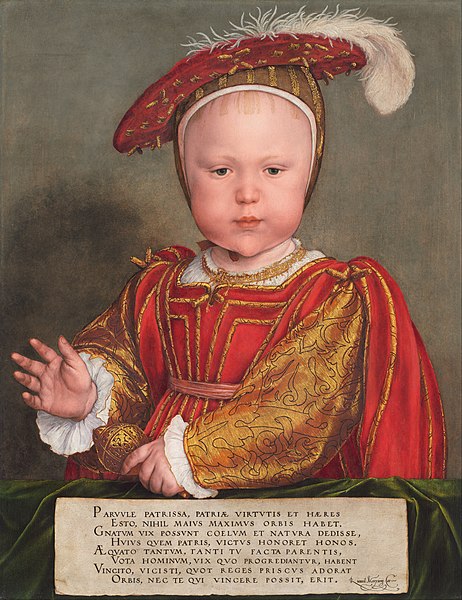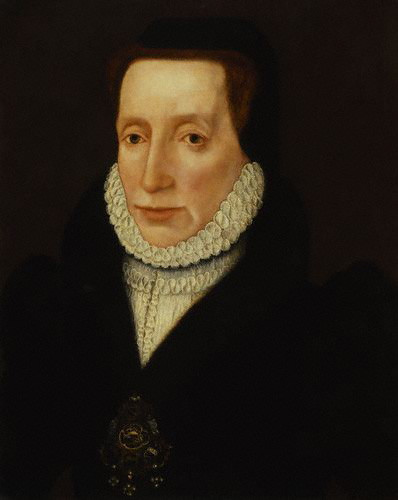 |
| Princess Mary |
The Birth of a Princess
Three months
later Anne presented Henry, not with the longed for son, but another daughter;
the princess Elizabeth. Elizabeth was christened on 10th
September. Thomas carried the train of his granddaughter’s baptismal gown and
George was one of those carrying the canopy of estate above Elizabeth’s head.
Anne’s
paternal aunts, Anne Shelton and Alice Clere, were appointed to take charge of
Princess Mary’s household. Anne was unkind to the young princess, harping on
about her half-sister Elizabeth’s superior status, while Alice allegedly
treated their charge less unkindly.
When Henry
was undertaking the process to disinherit Mary Anne Shelton informed her charge
that the king did not care what she did;
‘And if I were in the King’s
place I would kick you out of the King’s house for your disobedience.’[i]
Anne also
claimed that Henry was planning to behead his daughter for failing to take the
oath agreeing that the young Elizabeth was to take Mary’s place as the heir to
the throne. Anne’s bullying had its effect; Mary became ill, but even so would
not agree to take the oath.
The Enchantment Fails
 |
| Edward Seymour |
The
enchantment wrought by Anne was fast disappearing and Henry, disappointed in
the sex of his heir and Anne’s miscarriage in the late summer of 1534 , was
soon looking around for a new love and in the September found her in one of
Anne’s ladies; the young Jane Seymour, the daughter of Sir John Seymour of Wolf Hall[ii]. Jane, like Anne, refused
Henry’s advances and the gifts and honours bestowed upon her and her family,
especially her brother Edward[iii], grew in splendour the longer Henry
was thwarted.
Anne was
becoming a termagant; nothing could be better used to destroy any love that
Henry, a man notorious for his foul temper, felt for his new wife. When Anne
discovered that Henry was flirting with one of her ladies and threw a tantrum
Henry told her to put up with it.
In October
1535 Anne fell pregnant again and Henry was solicitous in public, but the
Bishop of Tarbes, a visitor to the court, observed;
‘The King’s love for his
wife is less than it has been, and diminishes every day because he has new
amours.’[iv]
Anne knew about Jane and the knowledge fed her
depression.
The Second Fall of Mary Boleyn
 |
| Viscount Lisle |
Sometime in
1534[v] Mary Boleyn, by now
pregnant, married William Stafford; Stafford was a second son and a common
soldier; no match for the queen’s sister. Stafford transferred to working at
the Calais garrison
under the command of Arthur Plantagenet, Viscount Lisle[vi], the king’s uncle. Stafford’s move
came after attending in the king’s train on his 1532 visit to France with Anne.
Mary had failed to request permission from her father and from Henry.
Thomas was
angered by this second marriage of his eldest daughter’s, as was her uncle
Norfolk. Once Thomas realised that Mary’s child had been conceived out of
wedlock he cut off her allowance. And he and Anne persuaded Henry to banish
Mary from court. Mary wrote to Cromwell begging him to intercede with her
sister and brother-in-law and also her parents;
‘Also I beseech you, good
Master Secretary, pray my Lord my father and my Lady my mother to be good to us
and to let us have their blessings, and my husband their goodwill; and I will
never desire more of them.’[vii]
It would
appear that Mary then moved to live in Calais with her new husband.
The Fall of Anne Boleyn
In early
1536 Thomas was loaning monies to the value of £400[viii] to Lord Henry Daubeny[ix]. A correspondent of Viscount Lisle
wrote;
‘I have inquired of my Lord
Daubeny’s demeanour as secretly as I can……I have perfect knowledge that he hath
made shift with my Lord of Wiltshire for four hundred pounds.’[x]
Clearly,
whatever other storm clouds were on the horizon, Thomas’s financial affairs
were still in good order.
01.jpg/501px-Cromwell%2CThomas(1EEssex)01.jpg) |
| Thomas Cromwell |
But on 29th
January Anne gave birth to a still-born son; her last hope. Cromwell was
instructed to look for grounds for a second divorce. It was not until 24th
April 1536 that a secret commission headed by Cromwell and Anne’s uncle Norfolk
started work to find fault with the queen to enable Henry to divorce her and
marry Jane.
It took the
Commission a whole week to draw up a list of Anne’s alleged lovers; first and
foremost was her brother George closely followed by Mark Smeaton a court musician, Sir Henry Norris[xi] a courtier, Sir Francis Weston a Gentleman of the Privy Chamber and William Brereton[xii] a Groom of the Privy Chamber.
Within the
month Anne was on trial for treason; she was taken to the Tower in the first
week of May and and placed in the care of her paternal aunts, Anne Shelton and
Alice Clere, who were there to spy on her and report to the Commission.
On 12th
May Norris, Smeaton, Brereton and Weston were tried and condemned[xiii]. On 17 May 1536, George and his fellow accused were
executed for treason, and all George’s titles were forfeited[xiv].
After her husband's execution, George’s wife was absent from
court for several months. She was negotiating with Thomas; he eventually
allocated her a pension of £100[xv]. Anne went to the block on 19th.
Thomas and Elizabeth Boleyn retired to Hever and Thomas was replaced as Lord Privy Seal by Cromwell;
The Downward Trajectory
.svg/800px-Banner_of_the_Holy_Wounds_(Pilgrimage_of_Grace).svg.png) |
| Pilgrim's banner |
Thomas suffered a final indignity
as the claims of Piers Butler to the Earldom of Ormond were recognized and he
was styled earl of Ormond from 22 January 1538. There were two earls of Ormond in the Kingdom until Thomas’s death on 12 March 1539.
Two years after the deaths of two
of his children Thomas wrote to Erasmus requesting him to write a short
commentary on the 23rd psalm to be dedicated to himself. Although no
longer Lord Privy Seal, Thomas did retain his place on the king’s council. Two
months after Anne and George’s death Thomas was helping suppress the Pilgrimage of Grace[xvi].
 |
| Prince Edward |
Thomas was
recorded as attending the funeral obsequies of the woman who supplanted his
daughter; Jane Seymour died in childbirth on 24th October 1537, leaving
Henry with his longed for son Edward. Thomas was
as an agile a politician as his brother-in-law Norfolk;
‘These noblemen, we trust, will be ready to
give attendance at Hampton Court, and so to Windsor:-
My Lords of Norfolk,
Suffolk, Marquess [of] Dorset, Marquess [of] Exeter, the Earls of Surrey,
Oxford, Rutland, Wiltshire, Sussex, Hertford, Southampton, the Lord Privy Seal,
the
Lord Chamberlain[xvii], if
your Lordship have passed letters for them, as we trust you have.’[xviii]
Thomas then attended the
christening of Prince Edward; he kept in with Cromwell and other influential
politicians and attended the ceremonies of the Order of the Garter.
The Death of Doubting Thomas
 |
| Lady Margaret Douglas |
Thomas’s
wife Elizabeth died on 3rd April 1538 and Thomas’s younger sister
Alice died in the November; Thomas now only had two siblings still alive; Anne[xix] and James[xx] and of his children only
Mary was left. He had grandchildren; Anne’s daughter Elizabeth and Mary’s four
children[xxi]. By the end of 1538 Thomas was being ‘well entertained’ at court; there were
rumours that he was to wed Lady Margaret Douglas[xxii], the king’s niece.
While
contemplating his mortality Thomas considered cutting Mary out of his will and leaving
his money to his granddaughter Elizabeth. Thomas died on 12th March
1539 and was buried at Hever church. After Thomas’s death Hever Castle reverted
to the Crown. Henry ordered masses to be said for Thomas’s soul. Thomas’s
auditor wrote to Cromwell;
My good lord and master is
dead, he made the end of a good Christian man.’[xxiii]
Bibliography
Thomas
Cromwell – Robert Hutchinson, Phoenix 2008
Henry VIII –
Robert Lacey, George Weidenfeld & Nicholson & Book Club Associates 1992
The Earlier
Tudors – JD Mackie, Oxford University Press 1992
Rivals in
Power – David Starkey (ed), Toucan Books 1990
Elizabeth –
David Starkey, Chatto & Windus 2000
The Lisle
Letters – Muriel St Clare Byrne (ed), Penguin Books Ltd 1985 1533
The Six Wives
of Henry VIII – Alison Weir, Pimlico 1992
Mary Boleyn
– Alison Weir, AudioGO Ltd 2012
[i]
Mary Tudor - Prescott
[iii]
Cromwell was thrown out of his apartments at court so that Edward could be
housed close to his sister
[iv]
The Six Wives of Henry VIII - Weir
[v]
Probably in the summer
[vii]
Mary Boleyn - Weir
[viii]
In 2013 the relative: historic standard of
living value of that income or
wealth is £204,300.00
economic
status value of that income or
wealth is £6,188,000.00 economic power value
of that income or wealth is £71,670,000.00 www.measuringworth.com
[ix]
Created Earl of Bridgewater two years later
[x]
The Lisle Letters – St Clare Byrne (ed)
[xi]
Anne was accused of soliciting and having sex with Norris just ONE month after
the birth of Elizabeth; along with the other accusations this is extremely
unlikely given the number of servants, and attendants who would be scrutinising
Anne’s every move. Unlike Catherine Howard, Anne was not a stupid woman.
[xii]
Anne was accused of soliciting and having sex with Brereton a mere two months
after the birth of Elizabeth
[xiii]
Weir claims that Thomas was ‘probably’ involved in George and Anne’s trials
[xiv] His widow Jane continued to use
the title after her husband's death. Lady Rochford was herself attainted for
treason and beheaded on Tower Hill on 13 February 1542 with Queen Katherine Howard, the King's fifth wife
[xv]
In 2013 the relative: historic standard of
living value of that income or
wealth is £51,080.00
economic
status value of that income or
wealth is £1,547,000.00 economic power value
of that income or wealth is £17,920,000.00 www.measuringworth.com
[xvi]
An uprising in the north, protesting against the break from the Catholic Church
[xviii]
Rivals in Power – Starkey (ed)
[xix]
Who lived until 1555
[xx]
Who died in 1561
[xxi] His granddaughter Anne Stafford was born in
1536 and may still have been alive
[xxiii]
Mary Boleyn - Weir
Thank you very much for this detailed series. It's a great piece of research!
ReplyDelete